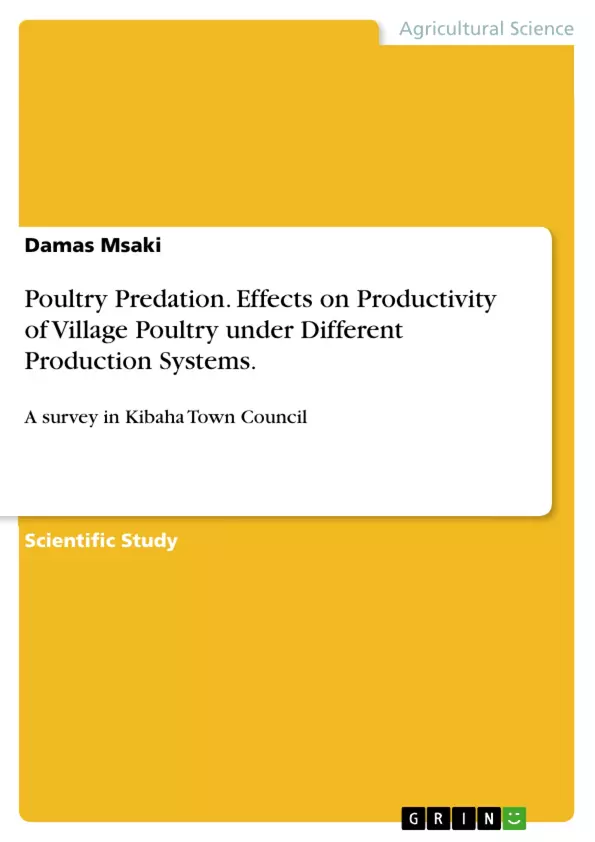This paper conducted a survey in five villages in 5 wards of Kibaha Town Council (KTC) to examine poultry production and predation causes of poultry losses in communal village areas. Qualitative and quantitative data were captured through a structured questionnaire administered to 94 households, then summarized and analyzed using the Statistical Package for Social Sciences (SPSS) and Microsoft Excel to depict descriptive statistics.
From those findings it shows that combined efforts should start immediately to eliminate IHCs and their preferred habitats, including use of environmentally friendly chemicals that totally eradicate them since they were singled out as the major predator causing many financial losses in poultry industry.
Inhaltsverzeichnis (Table of Contents)
- Abstract
- Introduction
- Materials and Methods
- Data collection
- Baseline Survey
- Data Analysis
- Results and Discussion
- Conclusions
- Acknowledgments
- References
Zielsetzung und Themenschwerpunkte (Objectives and Key Themes)
This study investigates the effects of predation on the productivity of village poultry in Kibaha Town Council (KTC). The research aims to explore the types of predators affecting poultry production, their impact on poultry losses, and the effectiveness of current predator management practices. The study examines the relationships between predation rates, poultry production systems, and the socioeconomic implications of predation for poultry farmers in KTC.
- Predation patterns and predator identification
- Effects of predation on poultry productivity
- Poultry production systems and their vulnerability to predation
- Current predator management practices and their effectiveness
- Socioeconomic impact of predation on poultry farmers
Zusammenfassung der Kapitel (Chapter Summaries)
The study begins with an introduction that highlights the importance of village poultry to the livelihoods of smallholder farmers in KTC, emphasizing the economic and food security roles of poultry. The introduction also discusses the challenges faced by poultry producers in KTC, including predation, poor nutrition, and diseases.
The second chapter outlines the materials and methods used in the study. This includes the data collection process, the survey design, the sampling strategy, and the analysis techniques employed to examine the quantitative and qualitative data gathered.
The third chapter presents the results and discussion, focusing on the characteristics of the respondents, the types of poultry kept, the prevalence of predation, the impact of predation on production, and the effectiveness of current predator management practices. The chapter analyzes the findings and discusses their implications for poultry producers in KTC.
Schlüsselwörter (Keywords)
The key terms and concepts that define the study include village poultry, predation, predator management, poultry production systems, productivity, livelihoods, food security, and socioeconomic impact. The study also focuses on specific predator species such as Indian house crows (IHC), weasels, and stray dogs and cats. The study analyzes the impact of predator management strategies, including the use of mosquito nets and other confinement methods.
- Quote paper
- Master of Science in Tropical Animal Production Damas Msaki (Author), 2017, Poultry Predation. Effects on Productivity of Village Poultry under Different Production Systems., Munich, GRIN Verlag, https://www.grin.com/document/1040284



